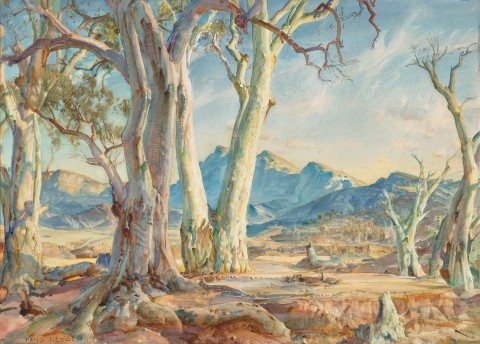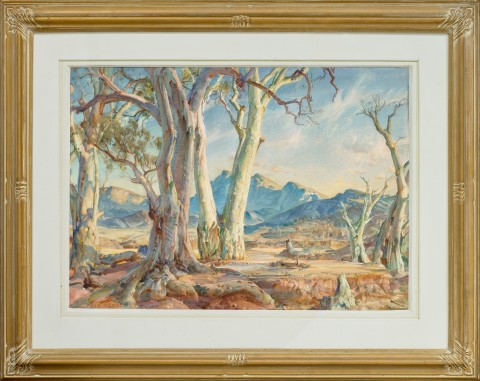(1877 - 1968)
Hans Heysen
In the Moralana Gorge, Flinders Ranges, 1954
watercolour on paper
Private collection, Melbourne, acquired directly from the artist in September 1954
Thence by descent
Private collection, Melbourne
In the Flinders - Far North, 1951, oil on canvas, 102.0 x 141.0 cm, National Gallery of Australia, Canberra
If one tree universally suggests Australia, it is the gum tree with its distinctive smell of eucalyptus. Such is its physiological hold that in 1902, when the artist Tom Roberts received a letter from the London-based Arthur Streeton complaining of homesickness, Roberts sent him dry gum leaves to burn in his fireplace as a temporary cure. On moving there himself in 1905, Roberts initiated an annual dinner at the restaurant Au Petit Riche in Soho for Australian artists living in England at which gum tree leaves were burned ‘with much ceremony at table in a censer.’1 Not surprisingly, Australia’s Indigenous people also revere the tree, deeming it sacred, and use it to promote health, to cleanse, and in ceremonies to cure the spirit. For Australian art lovers, Hans Heysen too will always be associated with gum trees, and In the Moralana Gorge, Flinders Ranges, 1954, is a clear demonstration why.
Heysen’s mastery of the subject is legendary and his focus forensic, but not to the point of clinical observation. Instead, his trees are beautifully rendered tributes to their might and individuality, writing in a letter from 1926 that ‘..there is something extremely exhilarating when tall white gums tower into the blue heavens – the subtle quality of the edges where they meet the sky – how mysterious.’2 That same year, Heysen took up the advice of a correspondent who had written to him about the lands around South Australia’s Finders Ranges with ‘such big gum trees, they would delight you.’3 The journey proved to be a revelation, and between 1926 and 1933, he made nine trips to the Ranges (sited on the traditional lands of the Adnyamathanha people) with two additional visits in 1947 and 1949. The clear distinction in the resultant landscape paintings was that Heysen had been made ‘curiously conscious of a very old land where the primitive forces of Nature were constantly evident.’4 These stark contrasts shifted his artistic direction too, introducing subtle modernist concepts of flatness and design.
Moralana Gorge lies on the western approach to Wilpena Pound, a natural amphitheatre enclosed by mountains, and Heysen’s mastery of watercolour is on full display here. This is not surprising as he had been already awarded the prestigious Wynne Prize for landscape painting six times between 1909 and 1931 for his watercolour entries. Having likely created related sketches of Moralana en plein air during the 1949 expedition, he was subsequently invited to submit a painting into the 1951 Jubilee Art Prize, which resulted in the powerful oil In the Flinders – far north, 1951 (National Gallery of Australia). In 1954, following a commission from an enthusiastic Melbourne collector who already owned a number of the artist’s works, Heysen reworked this painting as a watercolour, imbuing it with more light and colour than the original. Upon receipt, the new owner declared in a letter to the artist that this image of Moralana Gorge was ‘really outstanding… The spirit of the Flinders Ranges is truly reflected – the starkness, the depth & the strength. To say that we are delighted is an understatement.’5 Significantly, In the Moralana Gorge, Flinders Ranges has remained within the same family for the interceding period, only now available in the public domain for the first time in seventy years.
1. Smith, Bernard. Australian Painting 1788 – 1960, Oxford University Press, Melbourne, 1962, pp. 152 – 153
2. Hans Heysen, Letter to Lionel Lindsay, 14 March 1926, La Trobe Collection, State Library of Victoria, MS9104, cited in North, I., Hans Heysen, Sun Books, Melbourne, 1979, p. 11
3. Jessie C. Cook, Letter to Hans Heysen, 1911, cited in Theile, C., Heysen of Hahndorf, Rigby Ltd., Adelaide, 1968, pp. 135, 195
4. Hans Heysen, ‘Some notes on art’, Art in Australia, 3rd series, no. 44, June 1932, p. 18
5. Private correspondent, Letter to Hans Heysen, 3 September 1954
ANDREW GAYNOR


